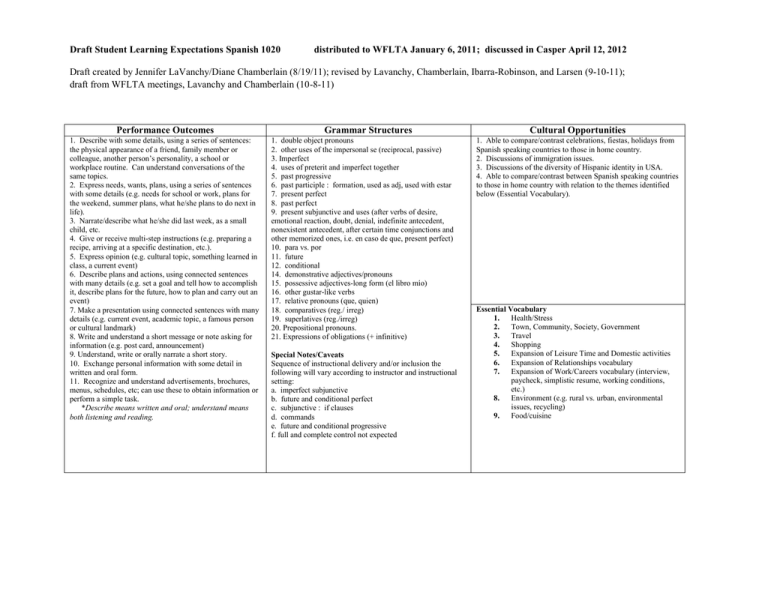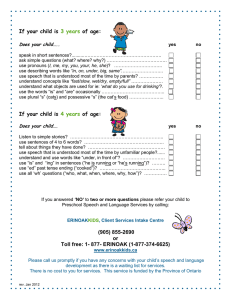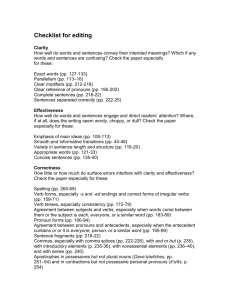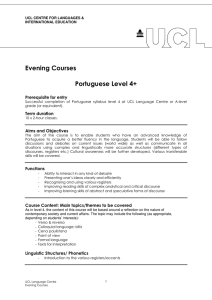Spanish 1020
advertisement

Draft Student Learning Expectations Spanish 1020 distributed to WFLTA January 6, 2011; discussed in Casper April 12, 2012 Draft created by Jennifer LaVanchy/Diane Chamberlain (8/19/11); revised by Lavanchy, Chamberlain, Ibarra-Robinson, and Larsen (9-10-11); draft from WFLTA meetings, Lavanchy and Chamberlain (10-8-11) Performance Outcomes 1. Describe with some details, using a series of sentences: the physical appearance of a friend, family member or colleague, another person’s personality, a school or workplace routine. Can understand conversations of the same topics. 2. Express needs, wants, plans, using a series of sentences with some details (e.g. needs for school or work, plans for the weekend, summer plans, what he/she plans to do next in life). 3. Narrate/describe what he/she did last week, as a small child, etc. 4. Give or receive multi-step instructions (e.g. preparing a recipe, arriving at a specific destination, etc.). 5. Express opinion (e.g. cultural topic, something learned in class, a current event) 6. Describe plans and actions, using connected sentences with many details (e.g. set a goal and tell how to accomplish it, describe plans for the future, how to plan and carry out an event) 7. Make a presentation using connected sentences with many details (e.g. current event, academic topic, a famous person or cultural landmark) 8. Write and understand a short message or note asking for information (e.g. post card, announcement) 9. Understand, write or orally narrate a short story. 10. Exchange personal information with some detail in written and oral form. 11. Recognize and understand advertisements, brochures, menus, schedules, etc; can use these to obtain information or perform a simple task. *Describe means written and oral; understand means both listening and reading. Grammar Structures 1. double object pronouns 2. other uses of the impersonal se (reciprocal, passive) 3. Imperfect 4. uses of preterit and imperfect together 5. past progressive 6. past participle : formation, used as adj, used with estar 7. present perfect 8. past perfect 9. present subjunctive and uses (after verbs of desire, emotional reaction, doubt, denial, indefinite antecedent, nonexistent antecedent, after certain time conjunctions and other memorized ones, i.e. en caso de que, present perfect) 10. para vs. por 11. future 12. conditional 14. demonstrative adjectives/pronouns 15. possessive adjectives-long form (el libro mío) 16. other gustar-like verbs 17. relative pronouns (que, quien) 18. comparatives (reg./ irreg) 19. superlatives (reg./irreg) 20. Prepositional pronouns. 21. Expressions of obligations (+ infinitive) Special Notes/Caveats Sequence of instructional delivery and/or inclusion the following will vary according to instructor and instructional setting: a. imperfect subjunctive b. future and conditional perfect c. subjunctive : if clauses d. commands e. future and conditional progressive f. full and complete control not expected Cultural Opportunities 1. Able to compare/contrast celebrations, fiestas, holidays from Spanish speaking countries to those in home country. 2. Discussions of immigration issues. 3. Discussions of the diversity of Hispanic identity in USA. 4. Able to compare/contrast between Spanish speaking countries to those in home country with relation to the themes identified below (Essential Vocabulary). Essential Vocabulary 1. Health/Stress 2. Town, Community, Society, Government 3. Travel 4. Shopping 5. Expansion of Leisure Time and Domestic activities 6. Expansion of Relationships vocabulary 7. Expansion of Work/Careers vocabulary (interview, paycheck, simplistic resume, working conditions, etc.) 8. Environment (e.g. rural vs. urban, environmental issues, recycling) 9. Food/cuisine



